Tuning Guide
By Steve Cockerill
With the possibility of sailors well in excess of 90kg sailing the Rooster 8.1, we have built in a large amount of luff curve the sail to support the leach – even when the mast is bending sideways under the full hiking load of the sailor. This means that the rig has to be set up differently to the Laser® Standard Rig sail that perhaps you may be more used to. If you were to merely use the equivalent vang (kicker) tensions of Laser® Standard Rig sail you would immediately notice, on an off-wind leg, that the luff of the sail is over-full and the shape of the sail is not balanced. This guide has been written to help you get the most out of your Rooster 8.1 Rig.
Pre sailing tips
If you are using the glass fibre sleeve in conjunction with a Laser® Standard Rig lower mast you will need to pack out the inner sleeve with tape to ensure a good interference fit with the lower mast and to pack out the joint of the upper mast to ensure a good fit in the extender tube. If you don’t ensure a good interference fit for both you may find your leach tension reduced which will reduce your pointing ability.
 Upwind 0-6 knots
Upwind 0-6 knots
Kicker tension should be block-to-block or more (the term block-to-block means sheet the mainsheet blocks together and pull the slack out of the kicker) You may have to use some Cunningham to help open the top of the sail (take a look at your tell tails) you may also find that with a new sail you have some luff curve creases that are there due to the luff curve of the sail not matching the oddities of different spar bends – with more use the sail cloth will get a little softer and accommodate these differences. Use of the Cunningham will also take these creases out. I flatten the Outhaul to reduce the drag and try to match the depth in the head of the sail. Perhaps only hand width depth in the bottom of the sail.
In the picture perhaps only 3-4 knots I have used lots of Vang to flatten the luff of the sail and used some Cunningham to unlock the upper leach and take out some luff to clew creases.
 Upwind 7-12 knots
Upwind 7-12 knots
The Vang tension needs to be increased with wind strength however, depending on your weight, you may be able to sail with less Vang tension at some point in the increasing wind. Personally at around 77kg there is no point for me where I need more power as I am on the light side for the rig. Therefore I go from underpowered and using Vang to unlock the sail to overpowered and needing Vang to de-power the sail very quickly. Again I flatten the sail in the base as I am not looking for power from depth as there is plenty of sail area, so I tend again to leave the foot at about hand width.
The picture shows no vang tension in 8 knots.
Upwind 12-20 knots
Again for me I am seriously overpowered and use immense Cunningham tension to windward Speaking to the heavier sailors who are sailing the boat well, the same is true. They have commented to me that the sail still needs a little wearing-in to get the best out of it, but they think that it is because there is less resistance to the use of Cunningham. Again Vang is used heavily and as a light person, I think I use more than the heavier sailors, but I am lucky that I am also quite agile as the increased Vang tension makes it hard to get under the boom! Heavier sailors are inclined to use less vang to de-power which at the same time gives the sailors more room to cross the boat. I think if you are new to Laser® style sailing, you might find the amount of Vang tension impedes your movement around the boat. Laser® sailors are often aware of easing the vang tension to tack in strong breezes. Control the foot of the sail with Outhaul tension to keep it as flat as possible without restricting the use of the Cunningham. Always get the Cunningham on first and pull the Outhaul on afterwards.
 Upwind above 20 knots
Upwind above 20 knots
You are looking for a challenge! Play the sheet constantly! I am not sure that there is a survival technique to employ. In the Standard Rig Laser® you might release the vang tension completely in over 35 knots in order to make good to windward so maybe this is worth a try. I also suggest you don’t ease the Outhaul!
Update from Steve, February 2009: At the Nationals Last year on the windy second day I decided to use as much Cunningham as I could put on. I used the old style both legs pull with straight arms. I figured that either the sail would break – or I would be able to sail fast against Greg Carey who is a big unit. It worked!! No I mean I was very very competitive. The mast bent on its own – a bit like a windsurfer rig – and I sailed to windward with no kicker – but with the sail block to block. It was so easy! I beat Greg to the first mark and the rest is history.
 Downwind 2-6 knots
Downwind 2-6 knots
As the introduction explains, we have a lot of fullness by the luff of the sail to distribute across the sail profile so use plenty of Vang tension. You will find that easing the Vang will not make the leach open any more or increase the flow over the sail, which is different to the Laser® Standard Rig in which you would ease the vang lots on a run. Use the red camber line to give you a clear indication of the fullness across the sail. In this picture I am able to run by the lee despite the lack of wind and with lots of vang, as the increased vang makes the flow attach to the sail. If you understand calibrations better, I use 75mm (approx 3″) more tension (measuring the 75mm as a distance the double block and becket on a 15:1 Vang has travelled away from the boom key block) than I would have used in similar conditions with a Laser® Standard Rig. I release the Cunningham and tend to keep the Outhaul quite tight, perhaps eased a little only as I tend to think of projected area rather than depth.
Downwind 7-12 knots
Not much change to the above. Perhaps you can ease the Outhaul and Vang a little on a deep reaching run as the fullness should move with the wind flow.
Downwind over 13 knots
Downwind 13 knots and above – hang on and enjoy the ride! The helm should be relatively easy as the rig is well over the bow reducing any weather helm but sit well back.
Reaching 4-8 knots
Your problem will be to unlock the upper leach. In this shot you can see that many of the boats still have plenty of Vang tension and no Cunningham tension
 Reaching in Over 12 knots
Reaching in Over 12 knots
You might want to hang onto the Cunningham as you go off wind to keep the fullness forward and avoid too much weather helm.










 Select Store
Select Store
 EU
EU
 US
US
